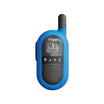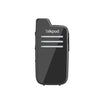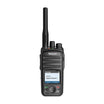The Continuous Digital Controlled Squelch System, commonly known as CDCSS, is a modern feature in the world of two-way radio communications that significantly enhances user experience by minimizing unnecessary noise. It's particularly useful in environments where multiple users share the same communication channel.
What is CDCSS?
CDCSS is an advanced squelch control method that uses digital encoding to silence the channel unless a specifically coded signal is received. Unlike traditional squelch systems that merely detect the presence or absence of a signal, CDCSS decodes a digital code embedded in the transmission to decide whether the incoming signal is intended for the receiver. If the incoming signal does not contain the correct digital code, the radio remains silent, effectively eliminating unwanted channel noise and interference from other users.
How Does CDCSS Work?
In two-way radios, the CDCSS feature works by embedding a low-level digital code—a sequence of bits—into the transmitted signal. This code is sent continuously along with the voice or data communication. When a radio equipped with CDCSS receives a signal, it checks for the presence of the correct digital code. If the code matches the one programmed into the receiving radio, the squelch is opened, allowing the audio to pass through and be heard. If the code is incorrect or missing, the radio remains quiet.
Benefits of CDCSS in Two-Way Radio Communications
-
Reduced Interference: By ensuring that only transmissions with the correct digital code are heard, CDCSS significantly reduces the likelihood of interference from other radios operating on the same frequency, leading to clearer communications.
-
Enhanced Privacy: While not a form of encryption, CDCSS provides a level of privacy by preventing users from hearing transmissions not intended for them, thus minimizing distractions and eavesdropping.
-
Channel Sharing: CDCSS allows multiple groups to share the same channel without constantly hearing each other's communications, making it an efficient use of limited frequency resources.
-
Improved Audio Quality: By eliminating background noise and unwanted transmissions, CDCSS improves the overall audio quality of the communication, making it easier to hear and understand messages.
Real-World Applications
CDCSS is invaluable in environments where radio traffic is heavy, and channel resources are limited, such as in security operations, event management, construction sites, and warehouse settings. By using CDCSS, teams can operate more efficiently, with less confusion and disruption from external radio communications.
Conclusion
The Continuous Digital Controlled Squelch System has transformed the way two-way radios are used in shared communication environments. By filtering out irrelevant transmissions and reducing background noise, CDCSS ensures that users can communicate more effectively, with fewer interruptions and clearer audio quality. This technology exemplifies how digital advancements continue to enhance traditional radio communication systems, making them more adaptable to the complex and noisy environments of today.












































